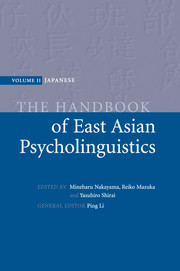Book contents
- Frontmatter
- Contents
- List of figures
- List of contributors
- In memory of Miwa Nishimura
- Preface
- Introduction
- Language acquisition
- 1 Ontogeny of language
- 2 Caregivers' speech
- 3 The intrinsic link between gesture and speech at the prelinguistic stage
- 4 Infant speech perception
- 5 Phonological acquisition
- 6 The mechanism of lexical development: implications from Japanese children's word learning
- 7 The acquisition of nouns and verbs in Japanese
- 8 The acquisition of verbal nouns
- 9 The acquisition of Japanese numeral classifiers
- 10 The acquisition of case markers
- 11 The acquisition of tense and aspect
- 12 On the origin of children's errors: the case of Japanese negation and direct passive
- 13 Binding Theory in UG and first-language acquisition of Japanese
- 14 The acquisition of the particles ne, yo, and no
- 15 The acquisition of linguistic politeness in Japanese
- 16 Children's narrative structures
- 17 Memory talk and testimony in children
- 18 Developmental dyslexia
- 19 Japanese Sign Language
- 20 The role of an innate acquisition device in second-language acquisition
- 21 Japanese, the grammar of reflexives, and second-language acquisition
- 22 Processes in L2 Japanese sentence production
- 23 The development of lexical competence among second-language readers
- 24 Reading in Japanese as a second language
- 25 Intrasentential code-switching in Japanese and English
- Part II Language processing
- References
- Name index
- Subject index
25 - Intrasentential code-switching in Japanese and English
from Language acquisition
Published online by Cambridge University Press: 05 June 2012
- Frontmatter
- Contents
- List of figures
- List of contributors
- In memory of Miwa Nishimura
- Preface
- Introduction
- Language acquisition
- 1 Ontogeny of language
- 2 Caregivers' speech
- 3 The intrinsic link between gesture and speech at the prelinguistic stage
- 4 Infant speech perception
- 5 Phonological acquisition
- 6 The mechanism of lexical development: implications from Japanese children's word learning
- 7 The acquisition of nouns and verbs in Japanese
- 8 The acquisition of verbal nouns
- 9 The acquisition of Japanese numeral classifiers
- 10 The acquisition of case markers
- 11 The acquisition of tense and aspect
- 12 On the origin of children's errors: the case of Japanese negation and direct passive
- 13 Binding Theory in UG and first-language acquisition of Japanese
- 14 The acquisition of the particles ne, yo, and no
- 15 The acquisition of linguistic politeness in Japanese
- 16 Children's narrative structures
- 17 Memory talk and testimony in children
- 18 Developmental dyslexia
- 19 Japanese Sign Language
- 20 The role of an innate acquisition device in second-language acquisition
- 21 Japanese, the grammar of reflexives, and second-language acquisition
- 22 Processes in L2 Japanese sentence production
- 23 The development of lexical competence among second-language readers
- 24 Reading in Japanese as a second language
- 25 Intrasentential code-switching in Japanese and English
- Part II Language processing
- References
- Name index
- Subject index
Summary
Bilingual code-switching
Code-switching, the alternating use of two or more languages in a situation, can be found in many bilingual communities in the world. The alternation between languages can be rapid, taking place even within a sentence boundary. Bilingual code-switching was once considered an exceptional case not practiced by “ideal” bilinguals who switch languages responding to a change in contextual factors such as interlocutors and topics (Weinreich, 1953). Recent studies, however, have shown that code-switching is practiced by those bilinguals who have a high proficiency in both languages (MacSwan, 1999; Nishimura, 1985; Poplack, 1980). It is now generally agreed that code-switching is a discourse mode, an appropriate way of speaking in certain speech situations in many bilingual communities (Gumperz, 1982; Heller, 1988; Myers-Scotton, 1993a; Nishimura, 1995a, 1997; Poplack, 1980).
Examples of code-switching are given in (1) and (2). In example (1) a Puerto Rican woman in New York City switches between English and Spanish; in (2) a nisei (second-generation Japanese) in Toronto, Canada, switches between English and Japanese:
(1) And from there I went to live pa'muchos sitios (“in a lot of places”). Despues vivi en la cieto diecisiete (“then I lived on the 117th”) with my husband. (Poplack, 1980)
(2) B.C. ni iku toki (“When I went to B.C.”), hikooki de yomoo to omotte kara (“thinking that I would read it on the plane”), I bought it, eh? So, it's not finished yet. (Laughs) And it's hard, 'cause me-nanka (“a person like me”), moo (“really”), hon-nanka yomu to (“when I read a book”), cover-to-cover yomanakattara (“unless I read it cover-to-cover”), if I stop dokka de (“at some point”), I forget the story. One week later you yomu deshoo (“When I read it a week later”), I gotta go back. (Nishimura, 1995a)
- Type
- Chapter
- Information
- The Handbook of East Asian Psycholinguistics , pp. 179 - 188Publisher: Cambridge University PressPrint publication year: 2006



